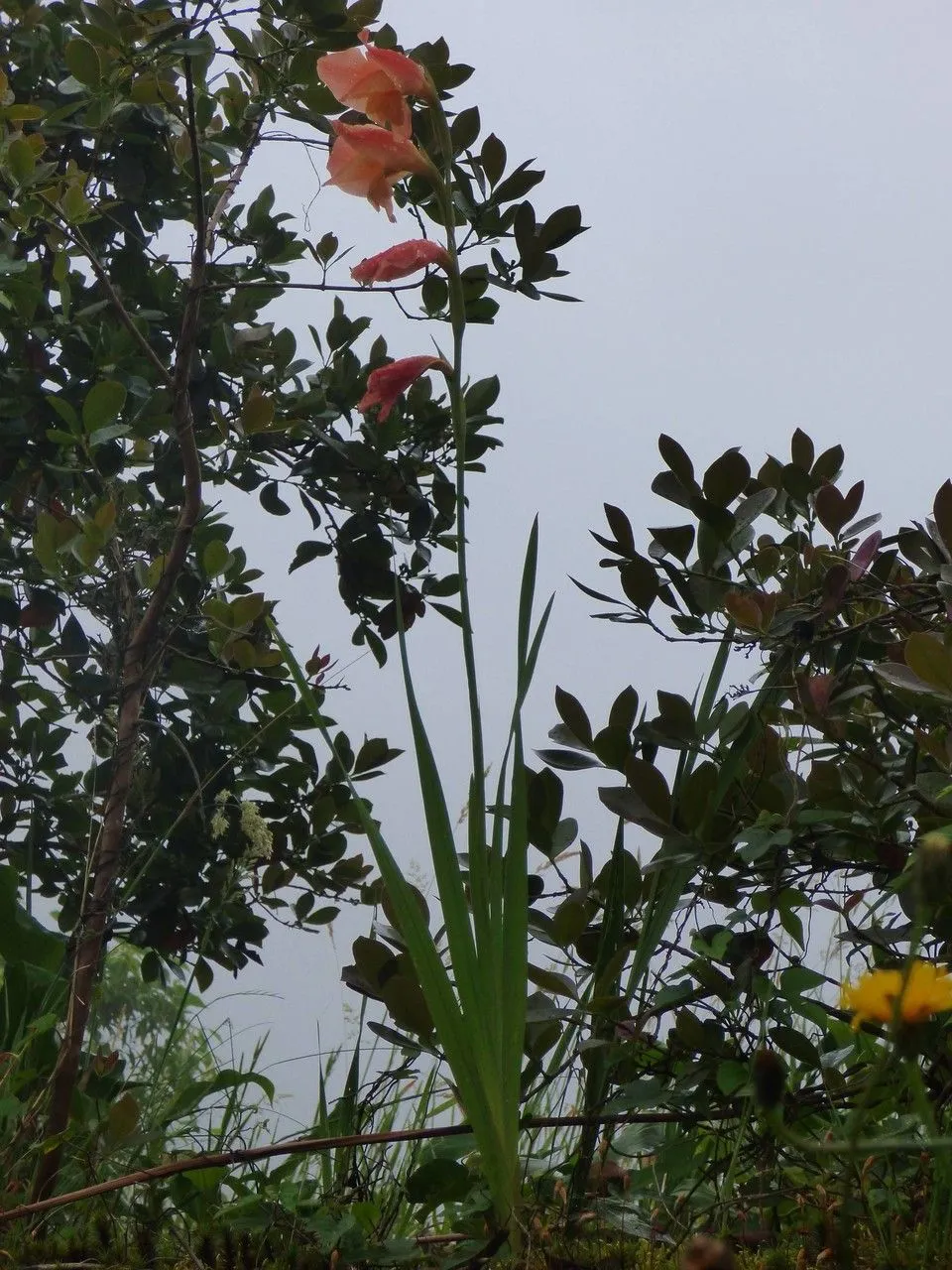
Author: Van Geel
Bibliography: Sert. Bot. 2(1): 18 (1829)
Year: 1829
Status: accepted
Rank: species
Genus: Gladiolus
Vegetable: False
Observations: Trop. & S. Africa, Madagascar, SW. Arabian Pen.
The Maid-of-the-mist, scientifically known as Gladiolus dalenii, is a strikingly beautiful plant that belongs to the Iridaceae family. Originating from tropical and southern Africa, as well as Madagascar and the southwestern Arabian Peninsula, this captivating species has managed to enthrall botanists and horticulturists alike since its introduction to the scientific community in 1829 by Van Geel.
Maid-of-the-mist is characterized by its elegant, tall spikes adorned with vibrant and tubular flowers that can exhibit a spectrum of colors, ranging from red and orange to yellow and even more delicate hues. These blossoms are not only visually captivating but are also arranged in a staggered, spiral formation, enhancing the aesthetic appeal of the plant.
The foliage of Gladiolus dalenii comprises sword-like leaves that arise from corms—modified underground stems that store nutrients, allowing the plant to survive seasons of dormancy and then flourish with vigor. These leaves add to the plant’s ornamental value, providing a lush and verdant backdrop to the colorful blooms.
Despite its exotic origins, the Maid-of-the-mist has proven to be resilient and adaptable, thriving in various climatic conditions provided it is planted in well-drained soil and receives ample sunlight. This adaptability makes it a favored choice among gardeners and landscape designers who seek to introduce a touch of the tropics into their outdoor spaces.
Flowering typically occurs during the warmer months, when Gladiolus dalenii showcases its full glory, attracting a myriad of pollinators, predominantly hummingbirds and bees, which are drawn to the plant’s vibrant colors and rich nectar. This interaction not only bolsters the ecosystem by promoting pollination but also adds a dynamic element to gardens, making them a hub of natural activity.
In addition to its ornamental use, Gladiolus dalenii holds cultural significance in several regions where it is native. It is often used in traditional medicine and local rituals, further cementing its status as a plant of both aesthetic and practical value.
Cultivating the Maid-of-the-mist requires some attention to detail. To ensure robust growth, it is advisable to water the plant moderately, taking care not to overwater, as this can lead to rotting of the corms. Fertilization during the growing season can support healthy development and flowering, while deadheading spent blooms encourages continual blossoming and maintains the plant’s decorative appeal.
In conclusion, Gladiolus dalenii, or Maid-of-the-mist, is much more than just a plant; it is a vibrant symbol of natural beauty and resilience. Whether appreciated for its ornamental charm, ecological interactions, or cultural significance, this enchanting species continues to be a beloved addition to gardens and landscapes around the world.
Eng: cornflag, natal-lily, dragon’s-head-lily, maid-of-the-mist, parrot-lily, sword-lily
En: Maid-of-the-mist, Dragon’s-head-lily, Natal-lily, Sword-lily, Parrot-lily, Cornflag
Fi: Liekkimiekkalilja
Fr: Glaïeul sauvage
De: Primel-Gladiole
Ml: ഗ്ലാഡിയോലസ് ഡാലെനി
Fa: گلایول دالنی
Taken Oct 17, 2017 by Hugo SANTACREU (cc-by-sa)
Taken May 21, 2019 by Aldrey Aldrey Pagkanlungan (cc-by-sa)
Taken Oct 17, 2017 by Hugo SANTACREU (cc-by-sa)
Taken Jun 23, 2021 by mary laituri (cc-by-sa)
Taken Sep 23, 2022 by Ortega Bobadilla (cc-by-sa)
© copyright of the Board of Trustees of the Royal Botanic Gardens, Kew.
© copyright of the Board of Trustees of the Royal Botanic Gardens, Kew.
© copyright of the Board of Trustees of the Royal Botanic Gardens, Kew.
Taken Nov 21, 2017 by Hugo SANTACREU (cc-by-sa)
Taken Oct 18, 2022 by Lisa Davies (cc-by-sa)
Taken Oct 17, 2017 by Hugo SANTACREU (cc-by-sa)
Taken Nov 25, 2019 by Bastian Dr. Bastian (cc-by-sa)
Taken Nov 17, 2022 by Marta Gross (cc-by-sa)
Taken Nov 21, 2017 by Hugo SANTACREU (cc-by-sa)
Taken Dec 10, 2019 by susan brown (cc-by-sa)
Taken Oct 18, 2022 by Lisa Davies (cc-by-sa)
Taken Dec 10, 2019 by susan brown (cc-by-sa)
Taken Oct 17, 2017 by Hugo SANTACREU (cc-by-sa)
Taken Jul 24, 2021 by Shehadi Ramiz (cc-by-sa)
Taken May 12, 2019 by Eli Small (cc-by-sa)
Taken Jan 9, 2019 by David Swan (cc-by-sa)
Taken Dec 2, 2017 by susan brown (cc-by-sa)
Taken Dec 2, 2017 by susan brown (cc-by-sa)
Taken Dec 2, 2017 by susan brown (cc-by-sa)
Taken Feb 27, 2022 by Giovanni Leonardi (cc-by-sa)
Taken Oct 21, 2021 by jurus (cc-by-sa)
Taken May 23, 2018 by susan brown (cc-by-sa)
Growth habit>: Forb/herb
Family: Myrtaceae Author: (F.Muell.) K.D.Hill & L.A.S.Johnson Bibliography: Telopea 6: 402 (1995) Year: 1995 Status:…
Family: Rubiaceae Author: Pierre ex A.Froehner Bibliography: Notizbl. Bot. Gart. Berlin-Dahlem 1: 237 (1897) Year:…
Family: Sapindaceae Author: Koidz. Bibliography: J. Coll. Sci. Imp. Univ. Tokyo 32(1): 38 (1911) Year:…
Family: Asteraceae Author: A.Gray Bibliography: Pacif. Railr. Rep.: 107 (1857) Year: 1857 Status: accepted Rank:…
Family: Fabaceae Author: Medik. Bibliography: Vorles. Churpfälz. Phys.-Ökon. Ges. 2: 398 (1787) Year: 1787 Status:…
Family: Aspleniaceae Author: (Cav.) Alston Bibliography: Bull. Misc. Inform. Kew 1932: 309 (1932) Year: 1932…